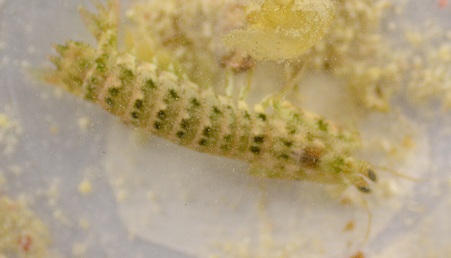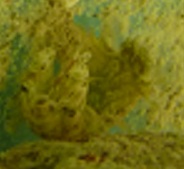The following is a university report regarding a personal study of Gonodactylus chiragra undertaken whilst I was on Heron Island, in Northern Queensland, Australia.

A diurnally active life cycle for a visually active predator?
Introduction
Many organisms follow a biological rhythm or cycle. Mantis shrimps are active predators and rely on a combination of stimuli for prey capture, including chemical, tactical, and optical stimuli (Schiff, Abbott & Manning 1986). Being visual predators, they would be expected to be most active during daylight hours, using the light to locate and capture prey. However, a study by Bolwig (1954) found G. falcatus and Squilla mantis responded negatively to daytime levels of illumination, and were most active under dark conditions. This finding conflicted with the existing knowledge of Gonodactylus, of which all species observed up to that point in time were known to be diurnally active (Schiff, Abbott & Manning 1986).
In the present study, the mantis shrimp Gonodactylus chiragra will be observed to determine if any diurnal patterns exist and if these can be manipulated by switching the pattern of day and night. It is expected that this species of mantis shrimp will be diurnally active as found in the majority of studies of this kind.
Methods
A study was undertaken while at Heron Island, Australia. Specimens were collected from Shark Bay and found in coral rubble in the intertidal area. Specimens included 2 juvenile and 3 adult G. chiragra mantis shrimps. Although no observations could be made of the juveniles as they were too small and cryptic to be able to gain any conclusions. Also midway through the study one of the adult specimens ‘escaped’ so the results were based on only two shrimps behavioural patterns. The study occurred under laboratory conditions and each specimen was held in a separate tank in constantly running seawater. Specimens were allowed to acclimate to their new surroundings for a 24 hour period before the study took place. However, behaviour during this period was noted. The activity of these mantis shrimps was observed over a 48 hour period. First over a normal day-night cycle and then this was switched to observe them during the day under dark conditions and during the night during light conditions. Each stomatopod had their own piece of coral rubble (collected from the area around Heron Island) to call home for the duration of the experiment. Activity was defined as movement which saw the mantis shrimp move its entire body from its present position to another. Each movement from one area to another constituted 1 measure of activity. Other notations on behaviour and feeding were also recorded during the study.
Results
Activity during the day was found to be much greater than that during the night. Switching day and night was observed to have no effect on these activity levels. The results are summarised into the following figure.
![]() ![]() 
Figure 1. Graph to show activity during both normal day and night cycles as well as that under dark conditions during the day and light conditions at night.
Discussion
From this data, it is evident that this species of stomatopod are more active during the day and less so at night. Even when conditions are manipulated, they continue as normal suggesting that they follow an instilled diurnal cycle. This data indicates that while this species of mantis shrimp are visual predators and use the light during the day to hunt, manipulation of this has little to no effect on their activity levels and thus they must follow an entrenched cycle which is independent of light levels. However, study over a longer period continuously switching night and day may find that they may modify this to follow light and dark cycles and become more active under light conditions once again. These results are consistent with the findings of a study by Dingle & Caldwell (1969) who found the species Gonodactylus bredini was also diurnally active.
Other observations made during the study regarding behaviour noted that the mantis shrimps were only seen feeding at daytime. Whether this was due to prey availability or simply failure to view this occurrence at night should be investigated further. Also, activity which occurred during the night, by the stomatopod, seemed to be the result of other activity in the study area. They are extremely inquisitive creatures and seem to watch and observe you as you do the same. Ideally the study could be carried out with no movement or disturbance through the use of video surveillance instead. However, the results from this study clearly show a pattern of activity exists in G. chiragra.
It was also noted during the study that the stomatopod would attempt to ‘close’ off the entrance to their home at night, using bits of rubble and sand which was then re-opened during the day. This behaviour was also observed in a study by Dingle and Caldwell (1969) in the mantis shrimp G. bredini, where they were observed to remove all detritus and debris and deposit it outside their burrows. Equivalent behaviour was observed in G. chiragra in the present study where the stomatopods cleaned out their new burrows and used this debris to close themselves off during the night.
Another behaviour which was observed was a coiling position, also observed in Dingle and Caldwell (1969), where the stomatopod doubles over itself so that its head is positioned directly above the telson (see figure 2). In the current study this behaviour was observed when the mantis shrimp was left without a burrow to hide, when it was threatened, or when it could not access the inside of a burrow. In Dingle and Caldwell however, this was one of the behaviours observed when mantis shrimps were placed in contact with one another. From this, I assume that this behaviour is a type of defence. Where a mantis shrimp feels threatened and cannot access its usual burrow to hide and resorts to hiding ‘within itself’. Further study into this behaviour is required though to make any significant conclusions.
a.  b. b.  c. c. 
Figure 2. Photos showing the coiling position in G. chiragra. |